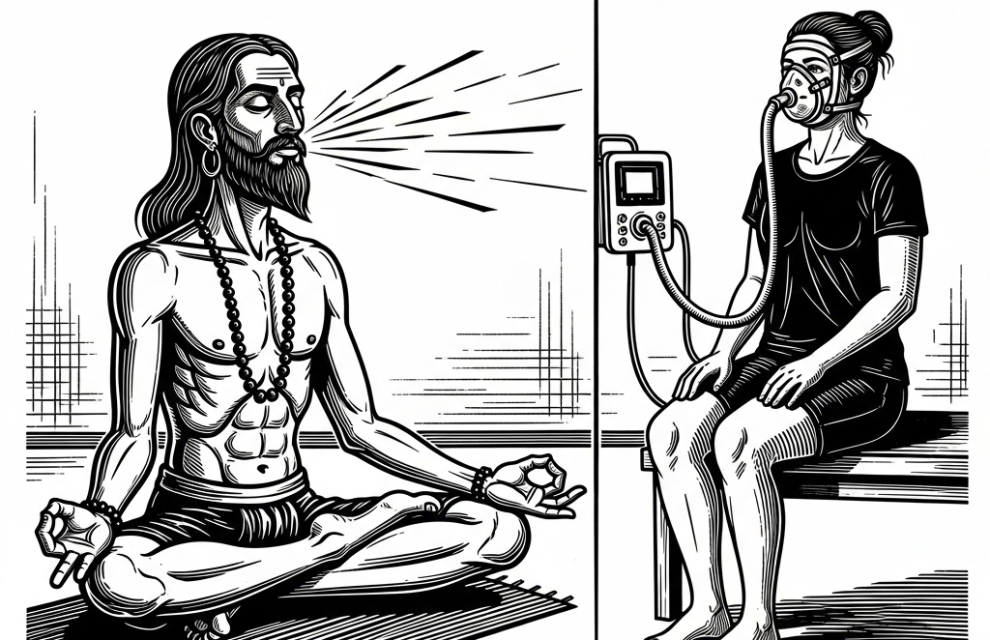In the digital age we love terms like “biohacking”—the idea of using science and technology to optimise our bodies for better health and performance. We track our sleep, monitor our heart rate, and even undergo passive therapies to enhance our cellular function.
But what if one of the most powerful biohacks has been around for thousands of years?
The ancient yogis, without modern tools or scientific studies, developed practices that anticipate our latest discoveries. One such practice is Bhastrika Pranayama, or “Bellows Breath,” and its striking similarity to modern Intermittent Hypoxia-Hyperoxia Training (IHHT) suggests a profound, intuitive understanding of the body.
Watch Me Performing Bhastrika Pranayama
https://youtu.be/5AHoV3Dl32M?si=zJ9HqKqSq5isNY3J
The Fire of Bhastrika: A Physiological Workout
Unlike calming breathwork that slows the nervous system, Bhastrika is a dynamic and forceful practice. It involves a series of rapid, rhythmic, and powerful inhalations and exhalations, followed by a breath hold. This vigorous, bellows-like action does more than just fill your lungs with air—it creates a dramatic fluctuation in your body’s internal environment.
Each hyperventilation builds up oxygen levels, and the rapid exhalation to empty the lungs expels a significant amount of carbon dioxide. The speed and intensity of this cycle create a fluctuating state of oxygen tension and carbon dioxide concentration in the blood.
This isn’t a long, sustained state of low oxygen like a single breath hold, but rather a rapid, repeated “stressor” that pushes your respiratory and cardiovascular systems to adapt.
IHHT: A Modern, Passive Parallel
Now, consider the modern therapeutic practice of Intermittent Hypoxia-Hyperoxia Training (IHHT). This therapy involves a person sitting passively and breathing through a mask that alternates between a low-oxygen, high-altitude-like air and a high-oxygen, enriched air.
The goal? To gently stress the body with controlled oxygen fluctuations. This non-invasive process is designed to stimulate the body’s natural adaptive responses, particularly on a cellular level. It encourages the body to:
- Based on the information I found, Intermittent Hypoxia-Hyperoxia Training (IHHT) is believed to offer a variety of health benefits by stimulating cellular adaptation. These benefits are similar to those of high-altitude training and include:
- Cellular Renewal and Anti-Aging: IHHT promotes the renewal and replacement of damaged mitochondria, which are the energy-producing powerhouses of your cells. This process is linked to anti-aging effects.
- Increased Energy and Stamina: By improving the efficiency of mitochondria, IHHT can lead to increased energy production, better physical performance, and reduced fatigue.
- Improved Cardiovascular Health: The therapy can enhance blood circulation, improve the elasticity of blood vessels, and may help to normalise blood pressure.
- Enhanced Metabolic Function: IHHT can influence metabolic processes, including the optimisation of fat burning and the regulation of blood sugar.
- Strengthened Stress Resistance: The controlled stress from the therapy can activate protective mechanisms in cells, leading to a greater resistance to oxidative and metabolic stress.
- Better Sleep and Cognitive Function: By improving oxygenation of the brain and supporting mitochondrial health, IHHT may lead to improved concentration, mental clarity, and sleep quality.
- Boosted Immune System: The therapy has been shown to mobilise stem cells and improve immune function, helping the body to fight off infections.
From Insight to Science
The parallel is remarkable. While the passive IHHT therapy achieves its benefits through a controlled machine, the yogis’ active practice of Bhastrika created a similar effect through sheer will and breath control.
It’s as if they intuitively knew that a repeated, dynamic challenge to the respiratory system—the very same principle behind IHHT—could lead to profound physiological benefits. They used their own bodies as the training device, creating a practice that not only builds mental discipline but also acts as a powerful cellular workout, promoting the very same kind of mitochondrial renewal and cellular resilience that we are just now beginning to understand with our modern technology.
Bhastrika Pranayama serves as a powerful reminder that the wisdom of ancient practices often contains a core of truth that modern science is only just catching up to. It’s a testament to the incredible connection between our breath, our body, and our ability to heal and renew from within.


